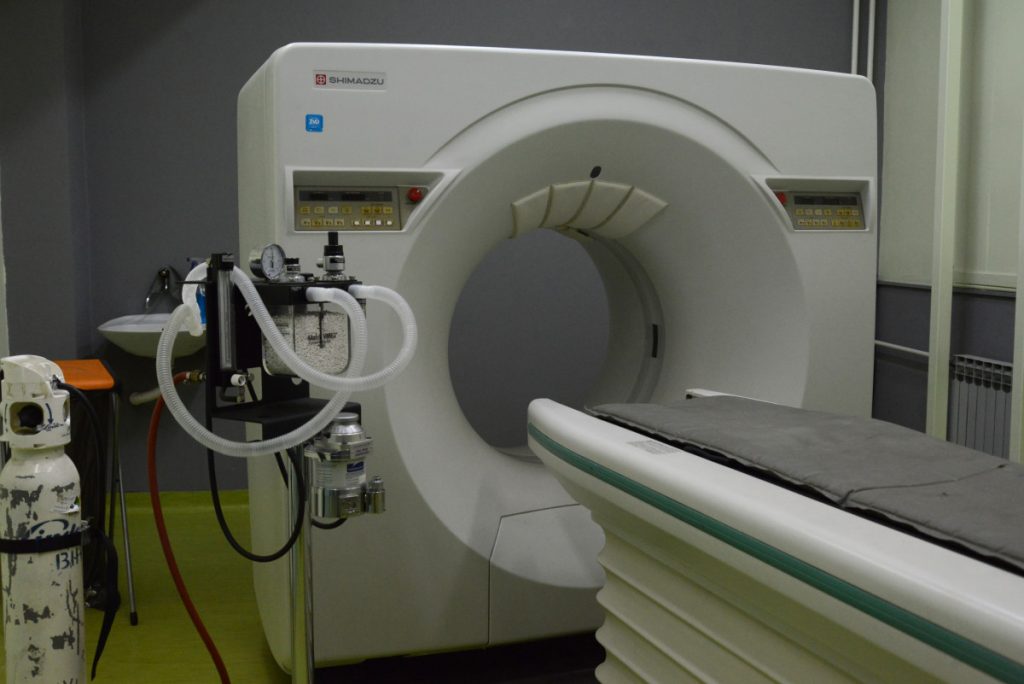The Clinic of the Veterinary Faculty of the University of Sarajevo exists for as long as the Faculty itself exists, and today it is the most modern clinic of its kind in Bosnia and Herzegovina. The team of the Veterinary Faculty Clinic at several departments provides services every day to animals who need help, whether they are hurt, sick, or need diagnosis or surgery.
Modern equipment and love for animals greatly facilitate this job, and guarantee full commitment to pets.
Modern CT
-Our task is to provide pet therapy and services and to educate students. People think that, since this is the Veterinary Faculty Clinic, the students work independently or perform practice on animals. It’s definitely not so. In our clinic, students do not work independently. This is more of a kind of help and they rarely work without our supervision – docent Doctor Denis Čamo, from the Department of Internal Animal Diseases, tells us at the beginning of the interview.

In the Clinic, there are several departments, that is, departments – for internal illnesses, diagnosis, surgery, and birth.
-We provide complete treatment for animals, from diagnostics to treatment. I am saying this because we certainly have the best diagnostics in Bosnia and Herzegovina. We are the only ones in Sarajevo who have digital X-ray, while others have digitized X-rays. We had the opportunity to compare our pictures with the pictures of other colleagues who work in Sarajevo and ours are far better – says Čamo.
In addition, for several years now, they also have a modern CT and they are currently the only Faculty in Bosnia and Herzegovina, but also the only faculty in the region that has this device.
-In addition, we renovated our surgery several years ago and now everything is in a very good condition. We also have a Clinic for Internal Diseases, which has the most modern equipment, from ultrasound, blood diagnostics … – says Čamo.
The primary advantage of this clinic is the number of people who work there, as well as experts.

– When several colleagues, Doctors of Science, sit down and talk about a case, we get much easier diagnosis than other veterinary stations. Also, we have accompaniment laboratories where doctors of science and pathology also work. There is also the Chair for Parasitic Diseases, and Department of Microbiology. We have really rounded up one whole and we offer a complete service to our patients – emphasizes Čamo.
Clinic of the Veterinary Faculty mainly provides services for pets, dogs and cats, but also works with exotic animals, and there are several doctors specialized for these types of animal. Working hours of the Clinic are every working day from 8 to 19 hours, and it is also planned to introduce a working time of 24 hours, as well as weekend work.
– This is necessary because of our clients, but also because of the request of the Association of veterinary education of Europe where we are trying to pass their standards so that our diplomas will be acknowledged in Europe – said Čamo.
Fifteen people work at the Clinic, in all departments. There are students working in a forst aid station, and when they have exercises from a certain subject, several people work with patient, they all go through a review.
A cat with tumor
– It cannot happen that we do not receive the patient because one of the colleagues is lecturing. We always have three or four colleagues who hold lectures, as well as professional associates whose primary work is with patients who, again, in cooperation with us, come up with diagnosis – says Čamo.

In order to provide patients with the best possible service and treatment, the Clinic fully follows the world trends, but they also go to additional education around the world. They have widespread cooperation with numerous European, but also American and Chinese faculties.
– In China, we were educated in acupuncture, that is, traditional Chinese medicine. We hope that we will provide our patients with these services, and that we will continue to develop cooperation with Chinese colleges – emphasizes Čamo.
He says he is particularly proud in one case, and that was the cat who was diagnosed with tumor of the lymphoma and which is the desease with most often fatal outcome in cats.
-That’s three years old case. After a great fight, we managed to save the cat, and six months ago it was removed from chemotherapy and is in very good condition. She is now coming to the therapy and we closely follow her case – he says.

